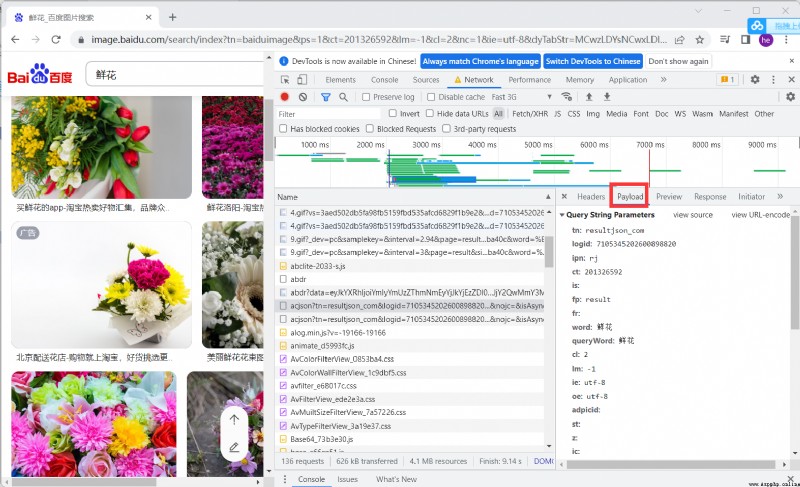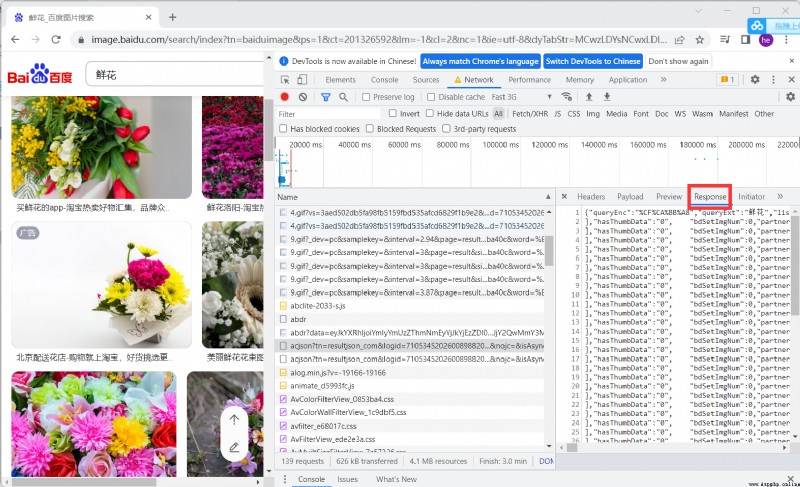When we learn about machine learning , Generally, we do not need to crawl the data by ourselves , Because a lot of algorithm learning is very friendly to help us pack the relevant data , But this does not mean that we do not need to learn and understand the relevant knowledge . Here we learn about three kinds of data crawling : flower / Crawling of star images 、 Crawling of Chinese artist images 、 Crawling of stock data . Learn and use three kinds of reptiles .

Find the packet for analysis , Analyze important parameters 
View the return value for analysis , You can see the picture system in ThumbURL in 
http://image.baidu.com/search/acjson? Baidu picture address
Splicing tn Visit to get the... Of each picture URL, In the return data of thumbURL in
https://image.baidu.com/search/acjson?+tn
To separate pictures URL Then visit download
import requests
import os
import urllib
class GetImage():
def __init__(self,keyword=' flower ',paginator=1):
self.url = 'http://image.baidu.com/search/acjson?'
self.headers = {
'User-Agent': 'Mozilla/5.0 (Windows NT 10.0; Win64; x64) AppleWebKit/537.36 (KHTML, like Gecko) Chrome/102.0.0.0 Safari/537.36'
}
self.keyword = keyword
self.paginator = paginator
def get_param(self):
keyword = urllib.parse.quote(self.keyword)
params = []
for i in range(1,self.paginator+1):
params.append(
'tn=resultjson_com&logid=10338332981203604364&ipn=rj&ct=201326592&is=&fp=result&fr=&word={}&queryWord={}&cl=2&lm=-1&ie=utf-8&oe=utf-8&adpicid=&st=&z=&ic=&hd=&latest=©right=&s=&se=&tab=&width=&height=&face=&istype=&qc=&nc=1&expermode=&nojc=&isAsync=&pn={}&rn=30&gsm=78&1650241802208='.format(keyword,keyword,30*i)
)
return params
def get_urls(self,params):
urls = []
for param in params:
urls.append(self.url+param)
return urls
def get_image_url(self,urls):
image_url = []
for url in urls:
json_data = requests.get(url,headers = self.headers).json()
json_data = json_data.get('data')
for i in json_data:
if i:
image_url.append(i.get('thumbURL'))
return image_url
def get_image(self,image_url):
## According to the picture url, Save picture
file_name = os.path.join("", self.keyword)
#print(file_name)
if not os.path.exists(file_name):
os.makedirs(file_name)
for index,url in enumerate(image_url,start=1):
with open(file_name+'/{}.jpg'.format(index),'wb') as f:
f.write(requests.get(url,headers=self.headers).content)
if index != 0 and index%30 == 0:
print(" The first {} Page download complete ".format(index/30))
def __call__(self, *args, **kwargs):
params = self.get_param()
urls = self.get_urls(params)
image_url = self.get_image_url(urls)
self.get_image(image_url=image_url)
if __name__ == '__main__':
spider = GetImage(' flower ',3)
spider()
if __name__ == '__main__':
spider = GetImage(' star ',3)
spider()
if __name__ == '__main__':
spider = GetImage(' Comic ',3)
spider()
import requests
import json
import os
import urllib
def getPicinfo(url):
headers = {
'User-Agent': 'Mozilla/5.0 (Windows NT 10.0; Win64; x64; rv:101.0) Gecko/20100101 Firefox/101.0',
}
response = requests.get(url,headers)
if response.status_code == 200:
return response.text
return None
Download_dir = 'picture'
if os.path.exists(Download_dir) == False:
os.mkdir(Download_dir)
pn_num = 1
rn_num = 10
for k in range(pn_num):
url = "https://sp0.baidu.com/8aQDcjqpAAV3otqbppnN2DJv/api.php?resource_id=28266&from_mid=500&format=json&ie=utf-8&oe=utf-8&query=%E4%B8%AD%E5%9B%BD%E8%89%BA%E4%BA%BA&sort_key=&sort_type=1&stat0=&stat1=&stat2=&stat3=&pn="+str(pn_num)+"&rn="+str(rn_num)+"&_=1580457480665"
res = getPicinfo(url)
json_str = json.loads(res)
figs = json_str['data'][0]['result']
for i in figs:
name = i['ename']
img_url = i['pic_4n_78']
img_res = requests.get(img_url)
if img_res.status_code == 200:
ext_str_splits = img_res.headers['Content-Type'].split('/')
ext = ext_str_splits[-1]
fname = name+'.'+ext
open(os.path.join(Download_dir,fname),'wb').write(img_res.content)
print(name,img_url,'saved')
We are right. http://quote.eastmoney.com/center/gridlist.html Crawling through stock data in , And store the data
# http://quote.eastmoney.com/center/gridlist.html
import requests
from fake_useragent import UserAgent
import json
import csv
import urllib.request as r
import threading
def getHtml(url):
r = requests.get(url, headers={
'User-Agent': UserAgent().random,
})
r.encoding = r.apparent_encoding
return r.text
# How much to climb
num = 20
stockUrl = 'http://52.push2.eastmoney.com/api/qt/clist/get?cb=jQuery112409623798991171317_1654957180928&pn=1&pz=20&po=1&np=1&ut=bd1d9ddb04089700cf9c27f6f7426281&fltt=2&invt=2&wbp2u=|0|0|0|web&fid=f3&fs=m:0+t:80&fields=f1,f2,f3,f4,f5,f6,f7,f8,f9,f10,f12,f13,f14,f15,f16,f17,f18,f20,f21,f23,f24,f25,f22,f11,f62,f128,f136,f115,f152&_=1654957180938'
if __name__ == '__main__':
responseText = getHtml(stockUrl)
jsonText = responseText.split("(")[1].split(")")[0];
resJson = json.loads(jsonText)
datas = resJson['data']['diff']
dataList = []
for data in datas:
row = [data['f12'],data['f14']]
dataList.append(row)
print(dataList)
f = open('stock.csv', 'w+', encoding='utf-8', newline="")
writer = csv.writer(f)
writer.writerow((" Code "," name "))
for data in dataList:
writer.writerow((data[0]+"\t",data[1]+"\t"))
f.close()
def getStockList():
stockList = []
f = open('stock.csv', 'r', encoding='utf-8')
f.seek(0)
reader = csv.reader(f)
for item in reader:
stockList.append(item)
f.close()
return stockList
def downloadFile(url,filepath):
try:
r.urlretrieve(url,filepath)
except Exception as e:
print(e)
print(filepath,"is downLoaded")
pass
sem = threading.Semaphore(1)
def dowmloadFileSem(url,filepath):
with sem:
downloadFile(url,filepath)
urlStart = 'http://quotes.money.163.com/service/chddata.html?code='
urlEnd = '&end=20210221&fields=TCLOSW;HIGH;TOPEN;LCLOSE;CHG;PCHG;VOTURNOVER;VATURNOVER'
if __name__ == '__main__':
stockList = getStockList()
stockList.pop(0)
print(stockList)
for s in stockList:
scode = str(s[0].split("\t")[0])
url = urlStart+("0" if scode.startswith('6') else '1')+ scode + urlEnd
print(url)
filepath = (str(s[1].split("\t")[0])+"_"+scode)+".csv"
threading.Thread(target=dowmloadFileSem,args=(url,filepath)).start()
It is possible that the data crawled at that time is dirty data , Running the following code may not run through , Do you need to process the data yourself or other methods
## Mainly used matplotlib Do image rendering
import pandas as pd
import matplotlib.pyplot as plt
import csv
import Stock data crawling as gp
plt.rcParams['font.sans-serif'] = ['simhei'] # Specified font
plt.rcParams['axes.unicode_minus'] = False # Show - Number
plt.rcParams['figure.dpi'] = 100 # Dots per inch
files = []
def read_file(file_name):
data = pd.read_csv(file_name,encoding='gbk')
col_name = data.columns.values
return data,col_name
def get_file_path():
stock_list = gp.getStockList()
paths = []
for stock in stock_list[1:]:
p = stock[1].strip()+"_"+stock[0].strip()+".csv"
print(p)
data,_=read_file(p)
if len(data)>1:
files.append(p)
print(p)
get_file_path()
print(files)
def get_diff(file_name):
data,col_name = read_file(file_name)
index = len(data[' date '])-1
sep = index//15
plt.figure(figsize=(15,17))
x = data[' date '].values.tolist()
x.reverse()
xticks = list(range(0,len(x),sep))
xlabels = [x[i] for i in xticks]
xticks.append(len(x))
y1 = [float(c) if c!='None' else 0 for c in data[' Up and down '].values.tolist()]
y2 = [float(c) if c != 'None' else 0 for c in data[' applies '].values.tolist()]
y1.reverse()
y2.reverse()
ax1 = plt.subplot(211)
plt.plot(range(1,len(x)+1),y1,c='r')
plt.title('{}- Up and down / applies '.format(file_name.split('_')[0]),fontsize = 20)
ax1.set_xticks(xticks)
ax1.set_xticklabels(xlabels,rotation = 40)
plt.ylabel(' Up and down ')
ax2 = plt.subplot(212)
plt.plot(range(1, len(x) + 1), y1, c='g')
#plt.title('{}- Up and down / applies '.format(file_name.splir('_')[0]), fontsize=20)
ax2.set_xticks(xticks)
ax2.set_xticklabels(xlabels, rotation=40)
plt.xlabel(' date ')
plt.ylabel(' Up and down ')
plt.show()
print(len(files))
for file in files:
get_diff(file)
The above describes three cases of data crawling , Different data crawls require us to perform different tasks URL To get , Input different parameters ,URL How to combine 、 How to get 、 This is the difficulty of data crawling , It needs some experience and foundation .